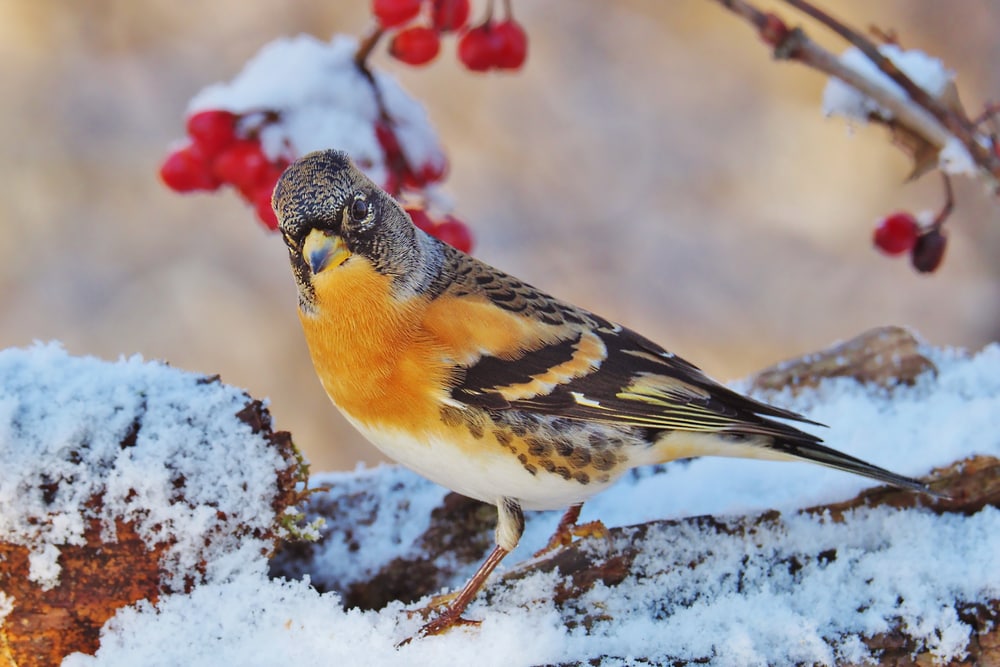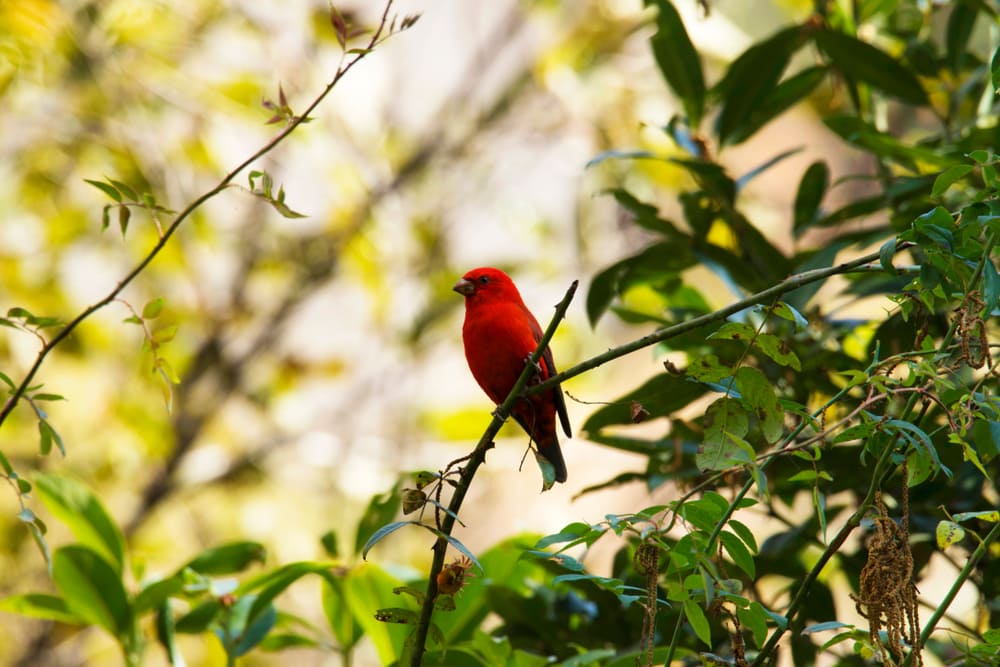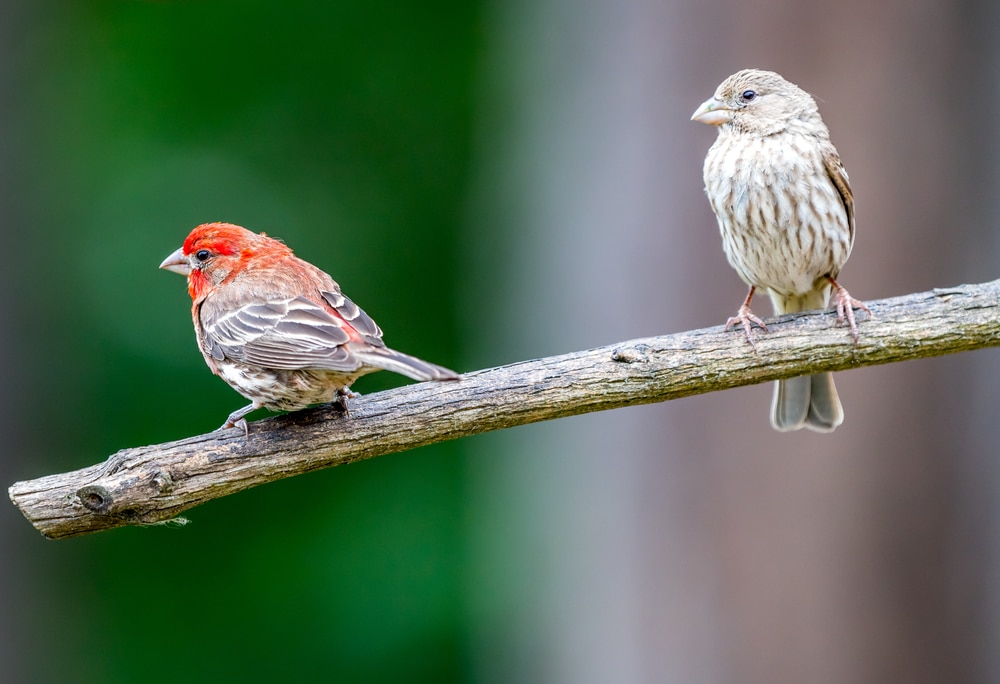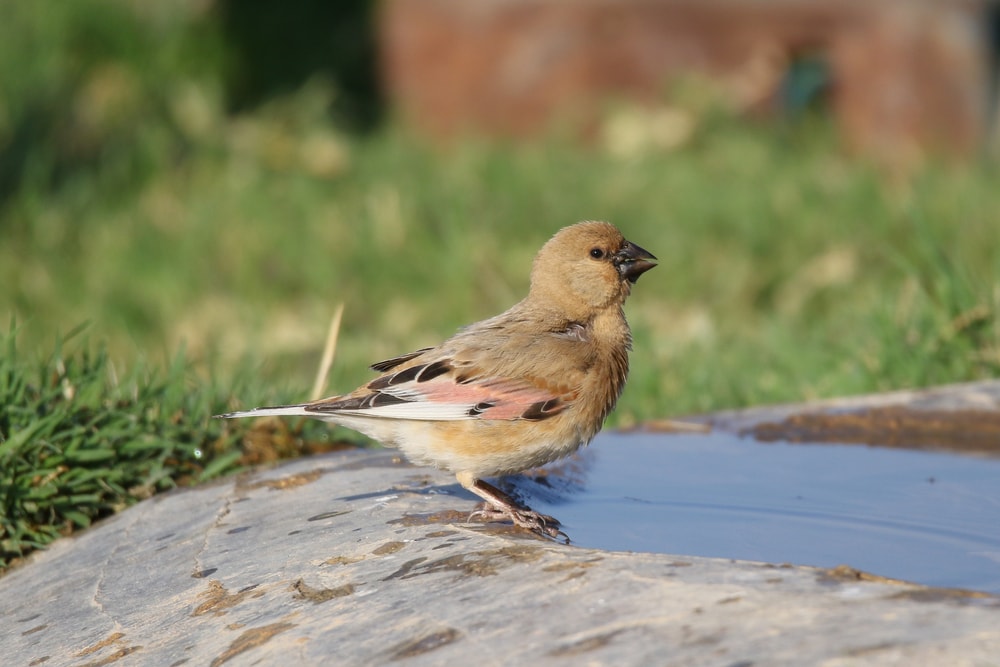
Finches are birds so small that you can easily miss them, but you can definitely hear them. These passerines are popular songbirds with their majestic warbles.
But did you know that some types of finches include other finches’ notes in their songs?
This article will discuss the 25 most remarkable types of finches worldwide. For example, we’ll explore upside-down finches and songbirds that can mimic others. We’ve also included photos and facts to introduce you to the hidden world of finches.
As a bonus, we will also discuss their fascinating and complicated classification. You can also learn how to attract them in your backyard. This way, the next time you spot a bird near your birdfeeder, you might recognize it.

Share This Image On Your Site
You May Also Like: 20 Types Of Sparrows Around The World: Field Guide, Photos + Fun Facts
25 Different Types of Finches

There are over 230 species seen as true finches, and it’s impossible to include them in one article. Thus, we’ve made a list of the 25 most exciting types of finches so that you can find out all about their fascinating lives.
1. American Goldfinch (Spinus tristis)

The American goldfinch is a tiny North American migratory bird. It flies between Alberta and North Carolina for breeding. Then, during wintertime, it goes to Mexico.
The species displays sexual dichromatism. The males are shiny yellow during summer and olive during winter. You can distinguish the females by their dull brownish color all year round. Males are shinier during the breeding season to attract females.
This finch species is a diurnal feeder, meaning it eats during the day. It is one of the strictest vegetarian birds in the world. Goldfinches are primarily granivorous and eat a lot of seeds. They have adapted to eating seeds by having a conical beak.
2. Common Chaffinch (Fringilla coelebs)

The common chaffinch, as the name says, is a common bird all over Europe, across the Palearctic, and Africa. This male finch has a blue-grey cap and red underparts, while females are duller.
These beautiful finches used to be famous caged songbirds.
By the 19th century, the common chaffinch was more often seen in cages than in London parks. This tradition continues in Belgium. They have a competitive animal sport called Vinkensport in which male chaffinches compete for the highest number of bird calls in one hour.
The male common chaffinch is very vocal and likes to sing to attract females. What’s more interesting is that they have regional dialects as well. Listen to an example of one singing beautifully in a forest during spring here:
3. Brambling (Fringilla montifringilla)

This small finch species is also called cock o’ the north or the mountain finch. The brambling is a migratory bird that flies all over the world. It travels between the forests of Europe, Africa, and even Alaska during its migration. There are around 200 million bramblings, but their numbers are declining.
Males have a unique pattern: black heads, dark upper parts, orange breasts, and white bellies. They like to fly in flocks, and millions gather together for migration. During winter, they eat seeds; during spring, they go for insects.
4. Evening Grosbeak (Hesperiphona vespertina)

The evening grosbeak is a North American finch with a bulky look and large bills. The males have bright yellow bodies with yellow patches on their black heads. Their wings are black with a white patch. Females are olive-brown with dark underparts.
This species lives in southern Canada and northern California. If food is scarce, they will migrate south to the rest of the United States. You can spot the evening grosbeak up in the mountains or forest areas. If you have a bird feeder in your backyard, you might attract them during winter.
The evening grosbeak feeds on seeds, berries, and insects. They have powerful beaks to crush seeds that other birds cannot open.
5. Hawfinch (Coccothraustes coccothraustes)

The hawfinch is a stocky finch and the only one placed in the genus Coccothraustes. You can find it all over Europe and Asia and rarely in the western islands of Alaska. The male hawfinch has an orange head with black eye stripes. Their bills are massive and dark during summer but paler during winter.
The hawfinch is a shy bird, so it’s hard to spot one. It usually stays on top of tree branches and comes to the ground to eat seeds.
When it’s drinking or eating, it’s aggressive towards everybody. It will guard a small territory near the nest during the breeding season. Outside of the mating season, it sometimes protects entire forests.
6. Pine Grosbeak (Pinicola enucleator)

The pine grosbeak or Pinicola enucleator means “the bird that lives in the pines and shells the seeds.”
You can find this adorable bird in coniferous forests in Alaska. It’s also widespread in the US, Canada, and subarctic Fennoscandia mountain areas. Adult males have a red tone all over their bodies, while females are yellow.
This subarctic-resident bird exhibits irruptive behavior. If food supply is scarce, it will travel great distances to find a suitable environment. Their songs depend on their geographical range.
7. Eurasian Bullfinch (Pyrrhula pyrrhula)

This is the first bird to get the bullfinch name. In Europe, this is simply called a bullfinch. Its Latin name comes from a Greek word meaning flamed-colored bird. Aristotle called it “a worm-eating bird.” This bird resides in Europe and temperate Asia. Some are migratory and go further south during winter.
The Eurasian bullfinch is a big bull-headed bird. You can easily distinguish the genders. The males have red underparts, while the females are grey.
They have weak singing, with some describing their notes as “mournful.” Bullfinches are capable of learning specific melodies. You can hear a sample of their song here:
8. Azores Bullfinch (Pyrrhula murina)

The Azores bullfinch is an endangered bird species native to the Azores. The locals call it the Sao Miguel bullfinch or priolo.
Like all finches, it has short wings and long tails. They look similar to the Euroasian bullfinch, with no red underparts. Males and females look pretty identical and have melancholic piercing notes.
The Azores bullfinch is the most threatened passerine bird. It is also the second-rarest bird in Europe.
By 2008 there were only around 700 individuals, and their numbers are declining due to habitat loss. It is a protected species under the European Union legislation. They are currently protecting and restoring the native laurel vegetation to preserve this bird.
9. Gray-Crowned Rosy-Finch (Leucosticte tephrocotis)

These are medium-large, chunky finches with black foreheads and gray crowns. Males, females, and juveniles spot the same coloring.
Due to its remote rocky habitat, this bird is rarely seen. It is endemic to Alaska and western Canada. They like to eat sunflower seeds and weeds.
These birds breed at higher altitudes than any other North American species. Unfortunately, scientists cannot study their breeding rituals because of the high altitudes. What’s known about them is that they are monogamous. They build their nests in hidden locations like rock cliffs and abandoned buildings.
10. Black Rosy-Finch (Leucosticte atrata)

You can easily recognize the rosy black finch by its greyish crown on a black head. Their bodies are a brownish color with pinkish bellies. Their legs are short, but their tails are long.
This bird is one of the least studied in North America because it lives in the alpine areas, above the treelines.
They primarily eat seeds during wintertime. When spring comes, they feast on insects and worms. Females hide their nests on rocky cliffs and niches between boulders. Both genders develop throat pouches during the breeding season for feeding the chicks.
11. Scarlet Finch (Carpodacus sipahi)

This gorgeous small bird has really bright red colors. It’s native to the Himalayas. It lives across Nepal and reaches Northeast India, Southeast Asia, and Thailand.
British naturalist Brian Hodgson first described it in 1893. He gave it a specific name because of its native land.
The Hindustani word “sipahi” means soldier. This finch is named for the red uniform worn by the men employed by the East India Company. While its name comes from soldiers, this bird is relatively inactive and sluggish.
12. Maui ʻalauahio (Paroreomyza montana)

The Maui ‘alauahio, or the Maui creeper, is a Hawaiian honeycreeper native to Maui, Hawaii.
Males are primarily olive-green with shiny yellow faces and bellies. Females are also yellow but not as bright as their male counterparts. To the untrained eye, this is barely noticeable.
These tiny birds are classified as endangered due to habitat loss. It happened due to the introduction of pigs and sheep. Invasive plants like strawberry guava also impact their habitat. The Maui creeper is also susceptible to avian malaria, with a 75% mortality rate.
Their calls are quite loud, making a “cheep cheep” sound. Their whistled warbles have “whichy-wheesee-whurdy-whew” high notes. More of their sounds here:
13. House Finch (Haemorhous mexicanus)

The house finch is a native North American bird. It can live everywhere, from parks to farms to urban areas. However, they can be noisy and aggressive. Males have a brown color with reddish faces and necks. The females have overall grey color.
They are originally from Mexico and were introduced to eastern North America in the 1940s. They were illegally sold in New York as “Hollywood Finches.” To avoid prosecution, they were released into the wild. They thrived and are now abundant all over eastern North America.
You can easily attract these birds with sunflower or nyjer seeds in tube feeders.
14. Desert finch (Rhodospiza obsoleta)

The desert finch, also called the Lichtenstein’s desert finch, is a big brown finch that lives in Eurasia. The male finch has a black bill with a dash of pink on each wing, while the female has duller colors.
This finch is a desert resident, but sometimes you can also see it at the base of the mountains. Its diet consists of seeds and insects. It has adapted to living next to humans in rural settlements and only migrates locally.
The female builds her nest up in trees during spring. She lays up to 6 greenish eggs.
15. Brimstone Canary (Crithagra sulphurata)

The brimstone canary is a small bird that belongs to the finch family. It is also known as the bully canary.
This tiny bird has pinkish feet, green upper parts, and yellow under parts. Sexes have similar coloring with the male being brighter.
This finch is native to Africa and rarely migrates, and if it does, only locally. It’s found in coastal areas in South Africa, in shrubs and gardens. The brimstone canary is a very vocal bird making deep “swirri swirrit” or chirrup sounds. You can hear their beautiful music here:
16. White-Winged Crossbill (Loxia lecoptera)

White-winged crossbills live in Canada and Alaska. Their preferred habitats are coniferous forests. The males are rosy-pink while the females are greenish. Their main activity is prying into cones using their twisted bills.
They live in flocks and hang upside down to eat. Individuals can eat up to 3,000 coniferous seeds per day. They usually breed all year round because the food is abundant.
The white-winged crossbill is an irruptive species. They will move further south when there aren’t enough cones in their areas. Here is a sample of the crossbill’s majestic song:
17. Purple Finch (Haemorhous purpureus)

Roger Tory Peterson has described the purple finch as a “sparrow dipped in raspberry juice.” The male is reddish with brown on its wings, while the females are an overall brown color. Purple finches spend their time in Canada to breed. After that, they overwinter in North America and the west coast.
This species is a master at breaking seeds with its powerful beak. They also use their beak and tongue to reach the nectar without eating the whole flower.
The purple finch has rich warbling songs. You can listen to their songs here:
18. Pine Siskin (Spinus pinus)

The pine siskin is a native North American bird. Its breeding range spans Canada, Alaska, and most of the northern parts of the USA.
You can spot this bird hovering over your bird feeder during wintertime. However, it won’t come again the following winter. They usually travel where the seeds are and always look for dependable food sources.
The pine siskin can survive very cold temeratures by stepping up its metabolic rates. For example, if temperatures drop below -94℉ (-70℃), they elevate their metabolic rate up to five times the normal rate for several hours. They also protect the eggs by building an insulated nest where the females stay continuously incubating them.
19. Lesser Goldfinch (Spinus psaltria)

They are inhabitants of the western USA and gather in scrubby oaks, cottonwood, and willow areas. They also visit suburban yards for seeds and water.
Males have different colorations depending on where they live. Male finches on the west coast have green backs, and the color varies elsewhere. The ones from Mexico have completely black backs.
The oldest known male lesser goldfinch was 7 years old when he was captured in 2015 in California. He was then released back into the wild. It’s unknown how much longer he lived. Like the purple finch, their songs include snippets from other birds’ songs.
20. Common Redpoll (Acanthis flammea)

The common redpolls are very energetic small finches that travel in flocks. They usually visit feeders during winter and eat catkins in birch trees. They are common in Canada and the northern US.
They live in the arctic tundra and boreal forests. However, their migration patterns change depending on the abundance of food. During irruption years, they end up as far as the central USA.
To survive harsh winter times, they bury themselves in snow tunnels. These tunnels can be more than one foot long (10 cm) under the snow. They can survive temperatures of -65℉ (-53℃).
21. Hoary Redpoll (Acanthis hornemanni)

This tiny finch received its “hoary” name due to its frosty plumage and “redpoll” for its berry crown patch. Males are distinguishable from females by having red blotches on their chests. These birds usually breed in the Arctic and sometimes move south in the winter.
Redpolls have something in common with the chipmunks. They have pouches in their throats where they can store seeds. They can later regurgitate them when they are in a safer spot.
The hoary redpoll is a fluffy bird that keeps warm during harsh winters. During warm spells, they pluck some of the feathers so as not to overheat.
22. Cassia Crossbill (Loxia sinesciuris)
The cassia crossbill spends its time in Idaho, USA. They are bulky birds, with a red-orange pattern all over their bodies and grey wings. Their bills are dark brown and large enough to break pine cones.
Crossbills like to have salt in their diet, so they find salt in the clay from upturned trees and lick it. They may also eat caterpillars and insects.
Their main food source is pine cone seeds because they don’t have to compete with red squirrels. Their Latin name sinesciuris means “without squirrels.”
23. Brown-Capped Rosy Finch (Leucosticte australis)

This brown-capped rosy-finch has a restricted range from Colorado to northern New Mexico. They have an overall brown color with pink patches on their wings, tail, and belly. Females have a black bill during breeding and a yellow bill the rest of the time.
They live in high mountains above the tree line. During winter, they will descend to lower elevations.
This finch likes to build its nests in remote areas like cliffsides and caves. It prefers to eat sunflower and Nyjer seeds. They don’t have songs; instead, they make buzzy chirps, which you can listen to here:
24. Lawrence’s Goldfinch (Spinus lawrencei)

Lawrence’s goldfinch is a small bird with an overall grey body. Males have black foreheads and throats with yellow bellies and chests. Their wings are black and yellow. Females have duller colors than males.
They are the most popular songbirds in North America. They live in the arid habitats of California and the desert.
It is a nomadic species, moving all year round in search of food and water. They are named after George Lawrence, a businessman from New York.
25. Cassin’s Finch (Haemorhous cassinii)

This bird’s main characteristics are thick straight-edged bills, short tails, and lined features. Males are all pinkish with a red on the crown, while females are brown and white with dark underparts.
Male finches have beautiful coloring because of carotenoid pigments. They get these pigments from eating foods like oranges.
This species lives in the mountains of western North America. Their habitats include tall evergreen forests and groves of aspen.
The Cassin’s finch mimics other birds and adds their calls into its song. Males sing during the breeding season to impress females. They usually stay in bachelor flocks during their first mating season. Listen to them in this link:
You May Also Like: The 18 Fastest Birds In The World
Classification

True finches belong to the Fringillidae family. They are small to medium-sized birds. Finches are seed-eaters, so they have small conical bills to break seeds or nuts easily.
Fringillidae comes from the Latin word “fringilla.” It means chaffinch, a member of this family commonly seen in Europe. You can find finches worldwide, except in Australia and polar regions.
There are over 200 species of finches, all divided into 50 genera. The most popular species are grosbeaks, redpolls, and canaries.
Do Finches Mate for Life?

During mating season, males sing to attract females. They also impress them with their beautiful plumage. Once a female decides on a partner, the pair usually mate for life. However, some species only remain faithful during that particular breeding season.
Both genders share responsibilities during the nesting period. The female stays on the eggs while the male provides food. When the chicks hatch, both parents feed them. Since they have an abundance of food, finches mate several times a year.
If the partner dies, some finches can undergo enormous stress. The zebra finch, in particular, can get so depressed that it can result in death.
On the other hand, widow finches that live in flocks can be cheered up by the flock’s energy, calls, and songs.
How Long Do Finches Live?

Depending on the species and size, finches can live up to 15 to 20 years. However, the most common lifespan is 10 years. Finches in captivity have longer lifespans because they don’t encounter the same stress as wild ones.
In the wild, finches need to forage daily for food, so their chances of being preyed on and eaten is higher. In addition, many migratory finches cannot fly to their new homes due to harsh weather conditions and end up in lakes or oceans.
How Do You Attract Finches?

The simplest way to attract finches to your backyard is to place birdfeeders in an area where finches would be safe from predators. Avoid placing the feeder next to shrubs or trees so squirrels won’t jump on them.
Finches like to feed on black-colored seeds like sunflower seeds. It’s also recommended to place fresh seeds into the feeders; otherwise, finches will avoid it. If you have thistle seeds, keep them in the freezer until you put them in the feeder.
Birds are attracted to shiny and colorful things, so decorate your garden with colored ribbons and colorful plants.
Blooming flowers and plants that produce seeds always attract finches. For example, you can plant dandelions or black-eyed Susans to attract goldfinches.
You May Also Like: 10 Fascinating Desert Birds And Their Unique Adaptations
Fun Facts about Finches

In the UK, USA, and Canada, finches and canaries were used in coal mines for carbon monoxide detection from the 18th to the 20th century. However, the UK stopped this practice in 1986.
A flock of goldfinches is called a charm.
Finches have been around for a long time, as fossils of true finches from the Middle Miocene era have been found. It means they lived 10 to 20 million years ago.
The smallest finch is the Andean siskin which is between 3.7 to 4.3 inches (9.4-10.9 cm). The smallest finch in America is the lesser goldfinch which is 3.5 to 4.7 inches (8.9-11.9 cm).
The largest finch is the collared grosbeak from India, reaching between 8.7 to 9.4 inches (22.1-23.9 cm). The pine grosbeak ranges from Canada to Alaska, reaching 7.9 to 10 inches (20.1-25.4 cm).
Types of Finches FAQ

What do finches eat?
Finches are granivorous, meaning they eat a lot of seeds. Some finches eat insects and berries.
Why won’t finches come to my feeder?
There can be multiple reasons why finches will not come to a feeder. First, check that your feeder is always clean and the seeds are black and fresh.
What is the most common finch?
The most common finch is the house finch. After they were introduced to Long Island, New York as cagebirds, they escaped and thrived in abundance.
What do finches symbolize?
In Native American tradition, finches symbolize celebration and joy. They are also seen as good omens.








